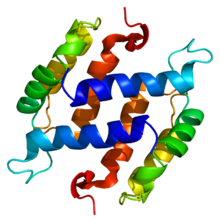The S100 proteins are a family of low molecular-weight proteins found in vertebrates characterized by two calcium-binding sites that have helix-loop-helix ("EF-hand-type") conformation. At least 21 different S100 proteins are known.[1] They are encoded by a family of genes whose symbols use the S100 prefix, for example, S100A1, S100A2, S100A3.They are also considered as damage-associated molecular pattern molecules (DAMPs), and knockdown of aryl hydrocarbon receptor downregulates the expression of S100 proteins in THP-1 cells.[2]
| S100/ICaBP type calcium binding domain | |||||||||||
|---|---|---|---|---|---|---|---|---|---|---|---|
 Structure of the S100B protein. Based on PyMOL rendering of PDB 1b4c. | |||||||||||
| Identifiers | |||||||||||
| Symbol | S_100 | ||||||||||
| Pfam | PF01023 | ||||||||||
| InterPro | IPR013787 | ||||||||||
| PROSITE | PDOC00275 | ||||||||||
| SCOP2 | 1cnp / SCOPe / SUPFAM | ||||||||||
| |||||||||||
Structure
Most S100 proteins consist of two identical polypeptides (homodimeric), which are held together by noncovalent bonds. They are structurally similar to calmodulin. They differ from calmodulin, though, on the other features. For instance, their expression pattern is cell-specific, i.e. they are expressed in particular cell types. Their expression depends on environmental factors. In contrast, calmodulin is a ubiquitous and universal intracellular Ca2+ receptor widely expressed in many cells.
Normal function
S100 proteins are normally present in cells derived from the neural crest (Schwann cells, and melanocytes), chondrocytes, adipocytes, myoepithelial cells, macrophages, Langerhans cells,[3][4] dendritic cells,[5] and keratinocytes. They may be present in some breast epithelial cells.
S100 proteins have been implicated in a variety of intracellular and extracellular functions,[6] such as regulation of protein phosphorylation, transcription factors, Ca2+ homeostasis, the dynamics of cytoskeleton constituents, enzyme activities, cell growth and differentiation, and the inflammatory response. S100A7 (psoriasin) and S100A15 have been found to act as cytokines in inflammation, particularly in autoimmune skin conditions such as psoriasis.[7]
Pathology

Several members of the S100 protein family are useful as markers for certain tumors and epidermal differentiation. They can be found in melanomas,[8] 100% of schwannomas, 100% of neurofibromas (weaker than schwannomas), 50% of malignant peripheral nerve sheath tumors (may be weak and/or focal), paraganglioma stromal cells, histiocytoma, and clear-cell sarcomas. Further, S100 proteins are markers for inflammatory diseases and can mediate inflammation and act as antimicrobials.[9] S100 proteins have been used in the lab as cell markers for anatomic pathology.
Human genes
Nomenclature
The "S100" symbol prefix denotes that these proteins are soluble in 100%, i.e. saturated, ammonium sulfate at neutral pH. The symbol has often been hyphenated,[12] but current gene and protein nomenclature, such as HUGO Gene Nomenclature Committee nomenclature, does not use hyphens in symbols.
See also
References
Further reading
- Wolf R, Voscopoulos CJ, FitzGerald PC, Goldsmith P, Cataisson C, Gunsior M, Walz M, Ruzicka T, Yuspa SH (2006). "The mouse S100A15 ortholog parallels genomic organization, structure, gene expression, and protein-processing pattern of the human S100A7/A15 subfamily during epidermal maturation". The Journal of Investigative Dermatology. 126 (7): 1600–8. doi:10.1038/sj.jid.5700210. PMID 16528363.
- Wolf R, Howard OM, Dong HF, Voscopoulos C, Boeshans K, Winston J, Divi R, Gunsior M, Goldsmith P, Ahvazi B, Chavakis T, Oppenheim JJ, Yuspa SH (2008). "Chemotactic activity of S100A7 (Psoriasin) is mediated by the receptor for advanced glycation end products and potentiates inflammation with highly homologous but functionally distinct S100A15". Journal of Immunology. 181 (2): 1499–506. doi:10.4049/jimmunol.181.2.1499. PMC 2435511. PMID 18606705.
- Wolf R, Voscopoulos C, Winston J, Dharamsi A, Goldsmith P, Gunsior M, Vonderhaar BK, Olson M, Watson PH, Yuspa SH (2009). "Highly homologous hS100A15 and hS100A7 proteins are distinctly expressed in normal breast tissue and breast cancer". Cancer Letters. 277 (1): 101–7. doi:10.1016/j.canlet.2008.11.032. PMC 2680177. PMID 19136201.
- Wolf R, Mascia F, Dharamsi A, Howard OM, Cataisson C, Bliskovski V, Winston J, Feigenbaum L, Lichti U, Ruzicka T, Chavakis T, Yuspa SH (2010). "Gene from a psoriasis susceptibility locus primes the skin for inflammation". Science Translational Medicine. 2 (61): 61ra90. doi:10.1126/scitranslmed.3001108. PMC 6334290. PMID 21148126.
External links
- S100+Proteins at the U.S. National Library of Medicine Medical Subject Headings (MeSH)
